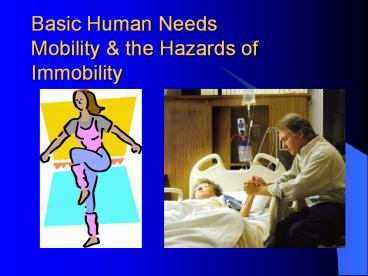Basic Human Needs Mobility PowerPoint PPT Presentation
Title: Basic Human Needs Mobility
1
Basic Human NeedsMobility the Hazards of
Immobility
2
Mobility serves many purposes
- Performance of ADL
- Satisfaction of basic needs
- Self-defense
- Expression of emotion
- Recreational activities
- Need intact functioning M/S nervous system to
achieve mobility
3
Principles of Body Mechanics
- Body Mechanics-coordinated efforts of M/S
nervous systems to maintain balance, posture
body alignment during lifting, bending, moving,
performing ADLs - Proper use of body mechanics reduces risk for
injury and ensures safe care
4
Principles of Body Mechanics
- Alignment
- Balance
- Gravity
- Friction
5
(No Transcript)
6
Regulation of Movement
- Skeletal system
- Skeletal system functions
- Characteristics of bone, joints,ligaments,
tendons, cartilage - Skeletal muscle
- Muscle tone
- Nervous system
7
(No Transcript)
8
Pathological Influences of Mobility
- Postural Abnormalities
- Impaired Muscle Development
- Damage to CNS
- Direct Trauma to M/S System
9
(No Transcript)
10
(No Transcript)
11
(No Transcript)
12
Systemic Changes Associated With Immobility
- Metabolic changes
- Endocrine metabolism affected
- (decrease in BMR)
- Disrupts metabolic functioning
- Fluid Lyte Imbalances
- Decreased calories protein
- Negative Nitrogen Balance
- Calcium Resorption affected
- Functioning of GI tract
13
(No Transcript)
14
Respiratory Changes
- Lack of exercise movement put client at risk
for - Atelectasis-Collapse of alveoli leading to
partial collapse of lung - Hypostatic Pneumonia- Inflammation of lung tissue
from stasis or pooling of secretions - Both decrease oxygenation, prolong recovery,
add to discomfort
15
(No Transcript)
16
(No Transcript)
17
(No Transcript)
18
Cardiovascular Changes
- Orthostatic hypotension
- Increased workload of heart due to decrease in
venous return to the heart - Risk for thrombus (Virchows Triad)
19
(No Transcript)
20
(No Transcript)
21
(No Transcript)
22
Musculoskeletal Changes
- Muscle effects (muscle atrophy)
- Skeletal effects- Disuse osteoporosis,
contractures and foot drop
23
(No Transcript)
24
(No Transcript)
25
Urinary Elimination Changes
- Stasis and pooling of urine in renal pelvis leads
to increased risk for infection and renal calculi - Risk for dehydration and decreased urine output
- UTIs due to foley catheter
26
Other Changes
- Integumentary changes (Risk assessment tool for
skin breakdown, proper skin hygiene) - Psychosocial effects (Depression from immobility)
- Developmental Changes
27
Nursing Process Immobility
- Assessment
- Assess immobilized client for hazards of
immobility - ROM exercises (PP pgs. 1435-1439)
28
Nursing Process Nursing Diagnosis
- You tell me!!!
29
Implementation
- Health Promotion
- Acute Care
- Metabolic system
- Respiratory system
- Cardiovascular system
- Musculoskeletal system
- Elimination system
30
Metabolic System
- Evaluate muscle atrophy
- IO
- Monitor lab data (BUN, albumin, protein,
electrolytes) - Assess wound healing
- Assess edema
- Assess for dehydration (Skin turgor, mucous
membranes) - Assess nutritional status (protein and vitamin
supplements, enteral feedings, TPN)
31
Respiratory System
- Frequent respiratory assessment
- Ascultate lung sounds
- Inspect chest wall movement
- Promote lung expansion and stasis of pulmonary
secrections - Deep breathing and coughing exercises
- Incentive spirometer
- Chest physiotherapy
- Suctioning
- Hydration
- Positioning every 2 hours
32
Cardiovascular System
- Vital sign monitoring
- Assess for orthostatic changes (Baseline BP)
- Reduce workload of heart
- Peripheral pulse assessment
- Assessment of edema (hearts inability to handle
increased work load) - Prevent thrombus formation
- Assessment of VTE/DVT (Calf circumference)
33
Prevent Thrombus Formation
- Anticoagulants (Lovenox, Heparin)
- TED Stockings
- Calf pumping exercises
- Sequential compression stockings
34
(No Transcript)
35
(No Transcript)
36
(No Transcript)
37
(No Transcript)
38
Musculoskeletal System
- Assessment of muscle tone, strength, loss of
muscle mass, contractures - Assess for risk of disuse osteoporosis
- Assessment of ROM
- Passive ROM for all immobilized joints
- Physical therapy consult
- Prevent foot drop and contractures
39
(No Transcript)
40
(No Transcript)
41
(No Transcript)
42
(No Transcript)
43
Elimination System
- IO each shift
- Assess for fluid electrolyte imbalances
- Bowel assessment
- Adequate hydration
- Incontinent considerations
- Assess bladder distention
44
Positioning techniques
- Footboard
- Trocanter roll
- Trapeze bar
- Pillows
- Splints
- Abductor pillow
- ROM exercises
45
(No Transcript)
46
(No Transcript)
47
(No Transcript)
48
(No Transcript)
49
(No Transcript)
50
Practice Scenario
- A 72 year old client is recovering following
abdominal surgery for colon cancer. Which
hazards of immobility is this client at risk for
and why? - How would you as the nurse prevent post-operative
complications associated with this clients
condition?
51
Clicker Question
- Which nursing assessment of the immobilized
client would prompt the nurse to take further
action? - A. Client complaining of fatique
- B. Urinary output of 50 ml/hr
- C. White blood cell count of 9.5
- D. Absence of bowel sounds
52
Clicker Question
- During an exercise session, the nurse assists the
client to dorsiflex and plantarflex the foot,
explaining the client needs to exercise the foot
to maintain function. The nurse recognizes this
type of exercise activity as - A. Active range of motion
- B. Passive range of motion
- C. Isometric exercise
- D. Isotonic exercise
53
Clicker Question
- Which of the following patients is most at risk
for thrombus formation? - A. Patient with renal failure
- B. Patient with severe abdominal pain
- C. Patient with a total hip replacement
- D. Patient with right sided heart failure
54
Clicker Question
- Which of the following is true concerning the
physiologic effects of immobility? - A. Serum calcium levels decrease.
- B. Hypertension develops because of increased
cardiac workload. - C. Caloric intake often increases.
- D. Secretions may block bronchioles.

